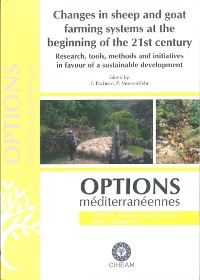| Article précédent | p. 55-60 | Article suivant |
Evolution des systèmes d'élevage caprin de l'Entre Douro e Minho : analyse des modes de production et des indicateurs de durabilité
Cette communication analyse l'évolution des modes de production et les résultats technico-économiques de deux élevages caprins, suivis depuis plus de 10 ans et dont la structure, le mode de production et la stratégie de développement sont très différents. L'un est un élevage pastoral, exclusivement orienté vers la production de viande et qui a ensuite évolué vers la production laitière et la fabrication fromagère ; l'autre élevage est un système semi-extensif, qui a fait le choix de la pluriactivité et de l'intensification de la production laitière. Les changements mis en oeuvre par les éleveurs, notamment en ce qui concerne les investissements, la commercialisation et la conduite des troupeaux, sont exposés. L'évolution est analysée à travers des indicateurs technico-économiques. L'adaptabilité de la main-d'oeuvre et le gain de temps dû à la possibilité de se dispenser du gardiennage du troupeau, permettent la diversification des activités de l'exploitation semi-extensive. Dans les deux exploitations, la valeur finale de la durabilité a été déterminée par sa dimension socio-économique.
This paper analyzes the evolution and the technical-economic indicators of two goat farms, which were surveyed for a long period of time (more than 10 years). They are two opposed cases in their structures, management and development strategies: the first one is a pastoral flock, which produced exclusively meat, but has changed to milk production and on-farm cheese-making. The second one is a semi-extensive system, with multi-activity and intensification of milk production. The changes implemented by the breeders, regarding investment, marketing and practices, are presented. The evolution is analyzed through technical-economic indicators. The labour flexibility and the working time-saving, due to the dismissal to guard the herd, allow, without disrupting, the diversification of the activities of the semi-extensive farm. In these two farms, the final value of sustainability has been determined by the socio-economic dimension.
- [ Afficher ]
- [ Télécharger ]
- [ Exporter la citation ]
Vous pouvez télécharger la citation au format :
- [ Imprimer ]
-
Mots-clés
CAPRIN, CONDUITE D'ELEVAGE, DURABILITE, INDICATEUR, PERFORMANCE ANIMALE, PORTUGAL, RESULTAT DE L'EXPLOITATION AGRICOLE, STRUCTURE D'EXPLOITATION AGRICOLE, SYSTEME D'EXPLOITATION AGRICOLECiter cet article
Pacheco F., Machado G., Cruz L. Evolution des systèmes d'élevage caprin de l'Entre Douro e Minho : analyse des modes de production et des indicateurs de durabilité. In : Pacheco F. (ed.), Morand-Fehr P. (ed.). Changes in sheep and goat farming systems at the beginning of the 21st century : research, tools, methods and initiatives in favour of a sustainable development . Zaragoza : CIHEAM / DRAP-Norte / FAO, 2009. p. 55-60. (Options Méditerranéennes : Série A. Séminaires Méditerranéens; n. 91). Proceedings of the Seminar of the Subnetwork on Production Systems of the FAO-CIHEAM Network for Research and Development in Sheep and Goats, 2007/11/15-17, Ponte de Lima (Portugal). http://om.ciheam.org/om/pdf/a91/00801124.pdf



